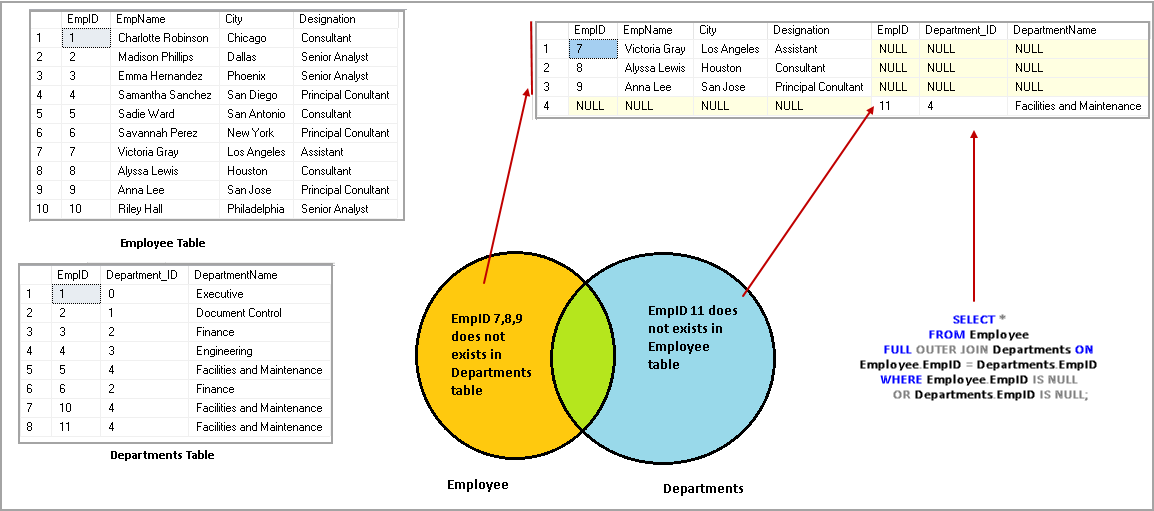What is the difference between an inner join and an outer join? SELECT column_name(s) FROM table1. In theory, a full outer join is the combination of a left join and a right join.
If the rows in the joined tables do not match, the result set of the full outer join contains NULL values for every column of the table that lacks a matching row. If rows from both tables meet the join_condition , the full outer join includes columns of both rows in the result set. FULL OUTER JOIN tableON table1. When no matching rows exist for the row in the left table, the columns of the right table will have nulls. If there are rows in “Customers” that do not have matches in “Orders”, or if there are rows in “Orders” that do not have matches in “Customers”, those rows will be listed as well.
A full outer join , or full join , which is not supported by the popular MySQL database management system, combines and returns all data from two or more tables, regardless of whether there is shared information. Think of a full join as simply duplicating all the specified information, but in one table, rather than multiple tables. SQL full outer join returns: all rows in the left table table_A. Here, the given condition could be any given expression based on your requirement. Consider the following two tables.
Table − CUSTOMERS Table is as follows. Initially, it applies inner join on Table_A and Table_B to retrieve matching tuples from both the tables. Then it extends those tuples of Table_A with NULL that do not have a matching tuple in Table_B. The Full Outer Join in Informatica is a part of Joiner Transformation which used to return all the existing records from Master table and Detail table. The result set of the full outer join has NULL values for every column of the table that does not have a matching row in the other table.
This type of join returns all rows from the LEFT-hand table and RIGHT-hand table with nulls in place where the join condition is not met. Conceptually, a full outer join combines the effect of applying both left and right outer joins. Full Outer Join Definition In a full outer join , rows from both tables that have not been returned in the result of the inner join are returned in the outer join result and extended with nulls. Suppose you have two tables named Tand T which are called the left table and the right table respectively. An full outer join is a method of combining tables so that the result includes unmatched rows of both tables.
The matching is based on the join condition. For the matching rows , a single row is included in the result set that contains columns populated from both joined tables. For those rows that do match, a single row will be produced in the result set (containing columns populated from both tables).
ODBC supports the SQL-left, right, and full outer join syntax. An outer join request must appear after the FROM keyword and before the WHERE clause (if one exists). Full outer join :To keep all rows from both data frames, specify how= ‘outer’. Left outer join:To include all the rows of your data frame x and only those from y that match, specify how= ‘left’.
Right outer join:To include all the rows of your data frame y and only those from x that match, specify how= ‘right’. For example - I have two tables - and this is the output required. It add all the matching rows from both the tables. If there is no match in both the table, it return null value for the missing cell.
The SQL Full Join or Full Outer Join is one of the SQL Join Type used to return all the records (or rows) present in both the Left table and the right table. All the Unmatched rows filled with NULL Values. It is commonly used in conjunction with aggregations to understand the amount of overlap between two tables. No discussion of OUTER JOINs would be complete without at least an honorable mention to UNION JOIN.
Figure 9–shows the syntax. As you might expect, not many commercial implementations support a UNION JOIN. If a value is missing when rows are joine that value is null in the result table. The join condition for a full outer join must be a search condition that compares two columns.
The predicates of the search condition can be combined only with AND. There are two types of table joins: inner join and outer join. This video explains full outer join or simply called full join. That is all rows from the left table and all rows from the right table. The full join keyword returns all rows from both tables.

So, the full join could return a very large result set. I’ll illustrate that for clarity.
Nincsenek megjegyzések:
Megjegyzés küldése
Megjegyzés: Megjegyzéseket csak a blog tagjai írhatnak a blogba.